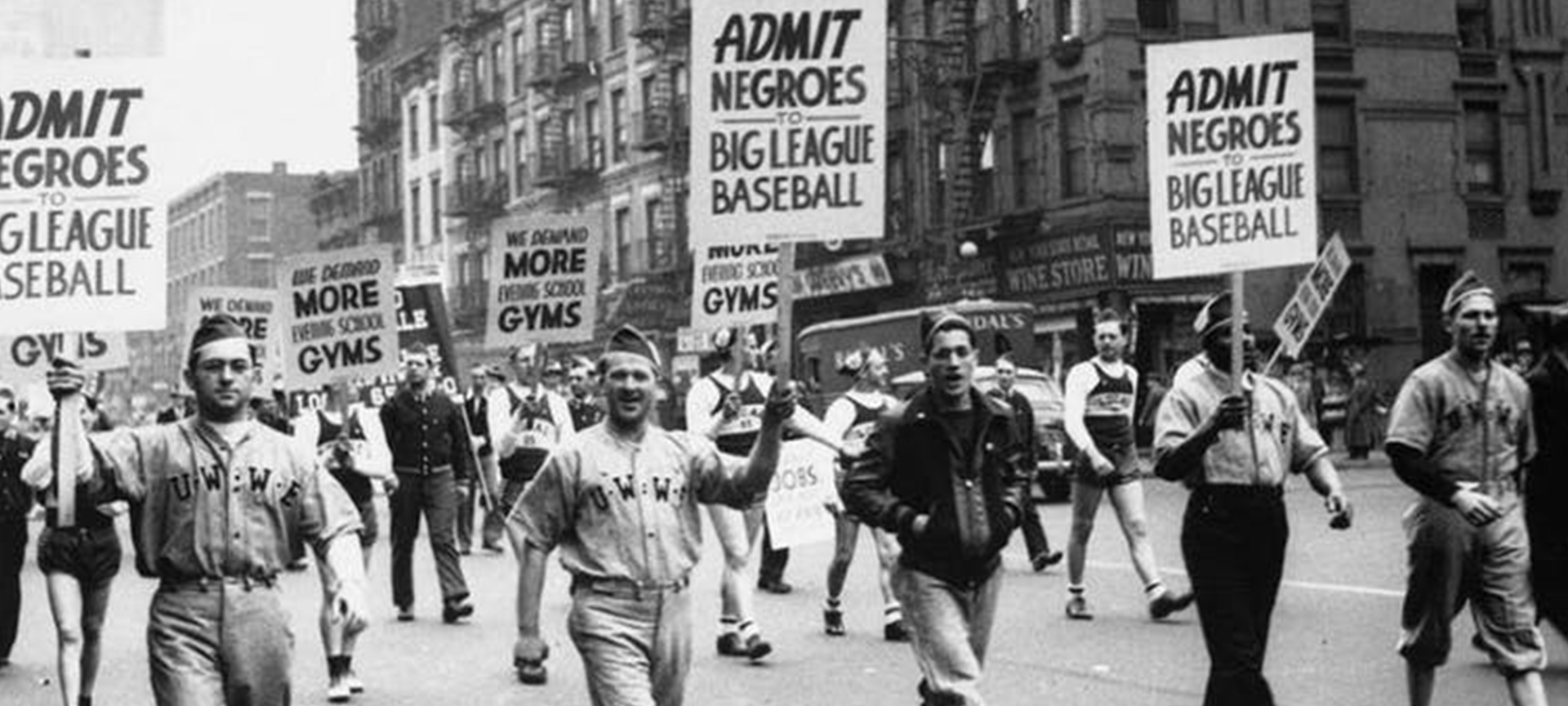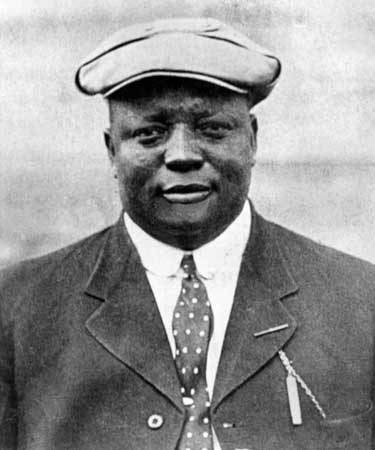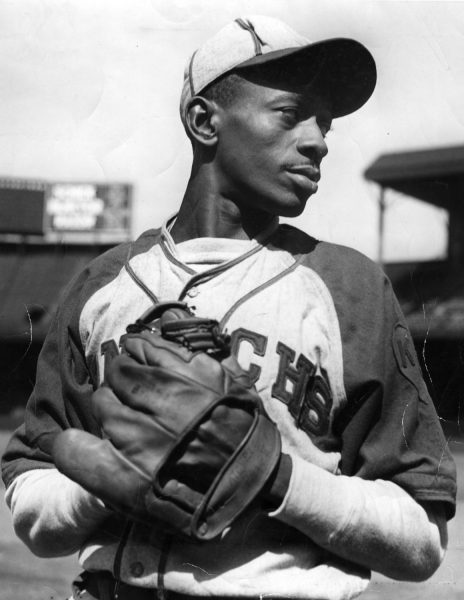2. Life in the North/Baseball in the North
After completing this or multiple sections of this lesson plan, please take 5 minutes to complete the survey at the bottom of this page. Your feedback will be extremely valuable for future curriculum updates and additions.
Part 2A:
Show students the Black Diamonds map below, explaining that each star represents a team in the Negro Leagues. Ask students the following question:
- Do you see any connections between this map and the previous map that illustrated the migratory patterns of the Great Migration?
To the teacher: The majority of the Negro Leagues teams were in the northern and midwestern destination cities of the Great Migration.
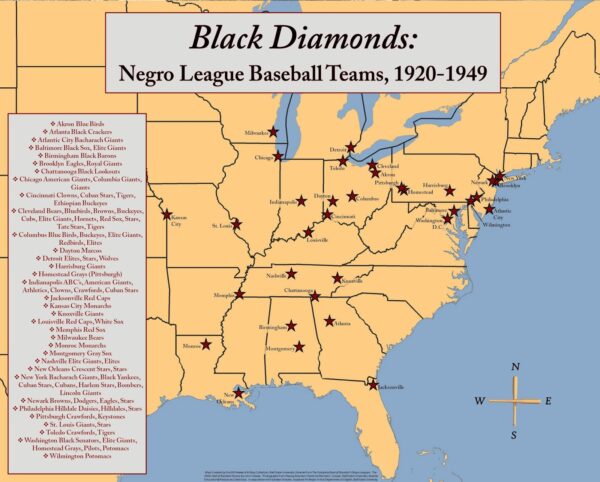
Locations of Negro Leagues baseball teams
Explain to students that the Negro Leagues were one reflection of a segregated America. Until 1947, Black baseball players and white baseball players had separate leagues. The division by race was reinforced by a de facto rule known as the “Gentlemen’s Agreement,” a segregation policy supported by white Major League team owners and other Major League stakeholders, including the commissioner of baseball. The so-called “Gentlemen’s Agreement” held that if you were non-white, you couldn’t play in Major League Baseball, no matter how skilled or talented you might be. Much like the Jim Crow laws, this policy enforced white supremacy, kept baseball segregated for many years and limited the opportunities and income of non-white athletes.
Importantly, the Negro Leagues were also a source of pride for much of Black America, with massive audiences attending games in the very stadiums that also hosted Major League Baseball events. Show students the photograph below of a Negro League game held at New York’s Polo Grounds, where the Major League’s New York Giants also played.
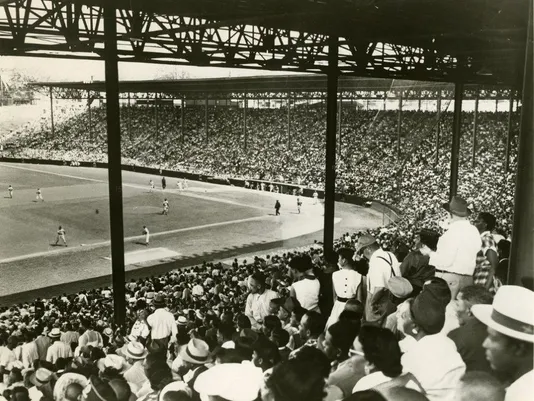
40,000 fans attend a Negro League game at the Polo Grounds, 1938
Questions for Students:
- What do you imagine it was it like to be an African American baseball player, knowing that segregation kept Black players out of Major League Baseball, despite the common conception that there was greater equality in the North?
To the teacher: Students may suggest that Black baseball players were likely disappointed, frustrated or angered by the segregation in professional baseball. It’s worth noting, however, that some former players have stated that they were so accustomed to the hostility of segregation that their situation was not surprising to them. Many have emphasized being happy to have played the game professionally in the Negro Leagues, despite the blatant inequities. Like other professional athletes and performers, they were glad to be welcomed by fans who treated them as star athletes and enjoyed the demonstration of their skills.
- Do you imagine Negro Leagues baseball players were well compensated? Why do you think that?
To the teacher: This will be addressed in the section that follows, but allow students to speculate. Although Negro Leagues players were making more money than the average American citizen at the time, they were making only a fraction of what their white counterparts earned, regardless of talent level. There was similar inequity in most careers in America at that time.
Show students the following chart, 1945 Average Yearly Salary.
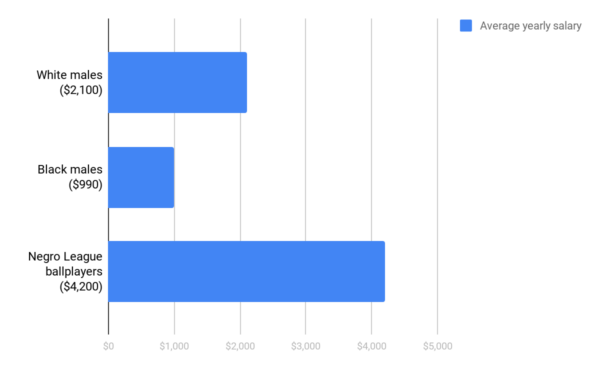
Questions for Students:
- What stands out for you about this chart? Who appears to be earning the most?
- After considering this graph, would you consider the Negro Leagues to be a good thing for African Americans?
Part 2B:
Show your students the following images and quotes on the screen. Explain that the first quote comes from Andrew “Rube” Foster, a longtime Negro League player, manager, team owner and Negro League founding president, who has been referred to as “the Father of Black Baseball.” The second quote is from Satchel Paige, who is widely considered one of the greatest pitchers in the history of baseball (Black or white), and spent the majority of his career playing in the Negro Leagues before he had the opportunity to join the Majors in his early forties.
To the teacher: The quotes below reveal two different perspectives on the Negro Leagues. Both Rube Foster and Satchel Paige make valid points about what the Leagues meant to African Americans.The aim in this lesson is to help students see that the Negro Leagues were a complex historical phenomenon. For example, while Rube Foster’s advocacy might be explained by his financial interest in the Negro Leagues, he may also have been critical of the larger social structures of segregation that limited his ability to be a team owner in a desegregated league. As the lesson progresses, encourage students to engage in the kind of critical thinking that makes room for a multiplicity of viewpoints regarding the Leagues and the wider social context in which they were embedded. Then, after the culminating debate, students can arrive at their own informed analyses regarding the Negro Leagues and their place in American history.
Questions for Students:
- Remember that Rube Foster was a businessman as well as a Negro Leagues player. Why do you think he might have had a positive opinion of the Negro Leagues?
To the teacher: The Negro Leagues provided entrepreneurial opportunities for African American business people that were extremely uncommon in the first half of the 20th Century.
- What do you think Satchel Paige means in his quote? How is he using the term “second class”? What does he mean by “immortal”?
Show your students the following chart, 1945 Average Salary in Baseball.
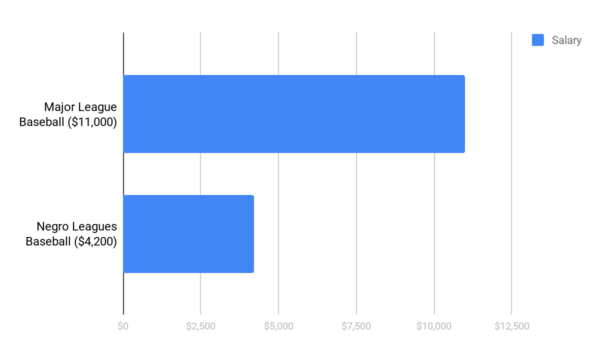
Questions for Students:
- What do you notice here? How is this different from the first salary chart we looked at?
- In your own words, explain how this chart may support Satchel Paige’s feeling that he had become a “second class immortal”?
To the teacher: Although Negro Leagues players were certainly making more money than the average American citizen at the time, they were making only a fraction of what their white counterparts earned, regardless of talent level.
Part 2C:
Debate Activity:
Divide your class into two groups. Give both groups the following Handout #2: Debate. Explain to students that one debate team will argue that the Negro Leagues were a positive development for Black Americans, while the other debate team will argue that segregation in the Major Leagues reinforced the racial inequities of American society. It will be up to each team to determine what content in Handout #2 best supports their respective argument. Give the teams time to prepare their positions, after which a debate will be held. Act as moderator, giving each side equal time to present their arguments. Be sure to emphasize that students should use the material on Handout #2 to support their respective positions.
Part 2D:
Watch the clip below as a class. Ask students to take notes, considering the pros and cons of the Negro Leagues. In the clip, sports writer and commentator Kavitha Davidson gives additional insight into the complicated history of the Negro Leagues.
As the clip and the earlier debate activity reveal, the segregation of Major League Baseball was a complex issue that divided even members of the Black community. Students should understand that the movement to desegregate baseball was underway for more than a decade before Jackie Robinson entered the Major Leagues. Black journalists, select politicians, members of both the Communist Party and labor unions all spoke out in favor of baseball’s desegregation, holding rallies and securing letters of support from such public figures as First Lady Eleanor Roosevelt. To reinforce this point, ask students to form small groups to read the following Handout #3 popcorn style and answer the questions that follow.
Part 2E:
Show students the lesson’s first clip from Ken Burns’ Baseball series. Ask them to take notes as they watch. Following this, read the quotes below from African American journalists who wrote in the time of World War II. They felt that if Black citizens could die for their country as soldiers, they should also have equal rights back home, including the right to play professional baseball in the Major Leagues. After considering the clip and the quotes, have students answer the questions that follow.
“Should I sacrifice my life [as a soldier] to live half American?”
—James Thompson, Pittsburgh Courier
“Good enough to die for his country, but not good enough for organized baseball.”
—Ben Davis, former Negro Liberator editor and New York City Councilman
(From a leaflet showing photos of two Black men, one a dead soldier and the other a baseball player)
“Major League Baseball is perpetuating the very things thousands of Americans are overseas fighting to end, namely, racial discrimination and segregation.”
—Wendell Smith, Pittsburgh Courier, 1942
Questions for Students:
- What was baseball commissioner Judge Landis’s view of the situation with segregated baseball leagues? Does he want to end segregation?
- Based on Ben Davis’s pamphlet, how did the war bring about a feeling that the segregation of baseball, among other things, needed to end?
- Expand on Wendell Smith’s quote. In light of the war, why do you think he sees segregation in the Major Leagues as hypocritical?
- Jackie Robinson said, “I was in two wars. One against a foreign enemy, the other against prejudice at home.” What do you think he meant?
Making Connections: Do you know any war veterans? How do these people describe the soldiers with whom they served? Does the experience of war, sometimes traumatic, create a bond between people? Relating this to African Americans serving in World War II, when whites and Blacks were making the same sacrifices for their country, do you think this bonding could have swayed public opinion about civil rights?
Part 2F:
Show students the second clip from Ken Burns’ Baseball series. After screening the clip, ask students the questions below.
Questions for Students:
- What did Branch Rickey do that was significant? How do you think Rickey felt about the “Gentlemen’s Agreement”?
- Based on what you’ve seen, what were some of the hardships Jackie Robinson faced as he took on the task of being the first Black baseball player in Minor League Baseball?
- Do you think Robinson’s challenges increased or decreased when he headed into the Major Leagues?
Part 2G:
Show students the third clip from Ken Burns’ Baseball series. Then ask students the questions that follow.
Questions for Students:
- What was the racial makeup of the audience that witnessed Jackie Robinson’s first Major League game?
- What do you think it was like for the Black members of the audience to watch Jackie Robinson that day at Ebbet’s Field in 1947?
- Gerald Early says in the clip: “You can almost divide American history before Robinson and after Robinson.” How would you interpret this statement?
- At the end of the clip, historian John Thorn says, “I’m most proud to be an American, most proud to be a baseball fan, when baseball has led America rather than followed it.” What do you think Thorn means when he says that “baseball has led America rather than followed it”?
- When John Thorn speaks of Jackie Robinson, he says: “I can think of no man having a more difficult road ahead of him than Jackie Robinson did in ‘47.” What did he mean? Wasn’t the hardest part of desegregation over?
Lesson Plan Home:
When Baseball Led America
Section 1:
Race & Movements Across the Map
Section 3:
Race & Baseball After Jackie Robinson
Post-Lesson Survey
Please complete this 5-minute, post-lesson survey. Your feedback will be extremely valuable for future curriculum updates and additions.

